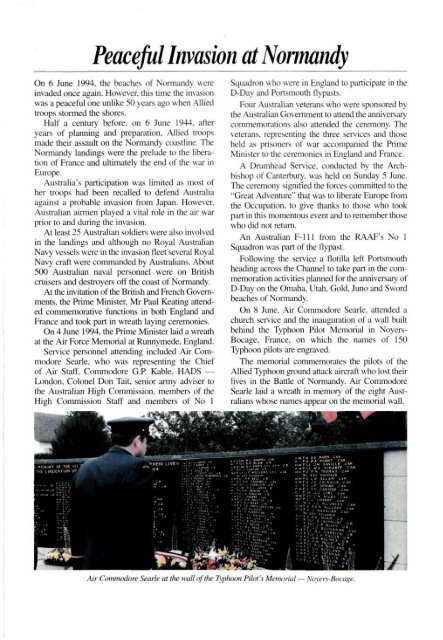ISSUE 107 : Jul/Aug - 1994 - Australian Defence Force Journal
ISSUE 107 : Jul/Aug - 1994 - Australian Defence Force Journal
ISSUE 107 : Jul/Aug - 1994 - Australian Defence Force Journal
Create successful ePaper yourself
Turn your PDF publications into a flip-book with our unique Google optimized e-Paper software.
Peaceful Invasion at NormandyOn 6 June <strong>1994</strong>. the teaches of Normandy wereinvaded once again. However, this time the invasionwas a peaceful one unlike 50 years ago when Alliedtroops stormed the shores.Half a century before, on 6 June 1944. afteryears of planning and preparation. Allied trtx>psmade their assault on the Normandy coastline. TheNormandy landings were the prelude to the liberationof France and ultimately the end of the war inEurope.Australia^ participation was limited as most ofher troops had been recalled to defend Australiaagainst a probable invasion from Japan. However.<strong>Australian</strong> airmen played a vital role in the air warprior to and during the invasion.At least 25 <strong>Australian</strong> soldiers were also involvedin the landings and although no Royal <strong>Australian</strong>Navy vessels were in the invasion fleet several RoyalNavy craft were commanded by <strong>Australian</strong>s. About500 <strong>Australian</strong> naval personnel were on Britishcruisers and destroyers off the coast of Normandy.At the invitation of the British and French Governments,the Prime Minister. Mr Paul Keating attendedcommemorative functions in both England andFrance and took part in wreath laying ceremonies.On 4 June <strong>1994</strong>. the Prime Minister laid a wreathat the Air <strong>Force</strong> Memorial at Runnymede. England.Service personnel attending included Air CommodoreSearle, who was representing the Chiefof Air Staff. Commodore G.P. Kable. HADS —London, Colonel Don Tait. senior army adviser tothe <strong>Australian</strong> High Commission, members of theHigh Commission Staff and members of No 1Squadron who were in England to participate in theD-Day and Portsmouth flypasts.Four <strong>Australian</strong> veterans who were sponsored bythe <strong>Australian</strong> Government to attend the anniversarycommemorations also attended the ceremony. Theveterans, representing the three services and thoseheld as prisoners of war accompanied the PrimeMinister to the ceremonies in England and France.A Drumhead Service, conducted by the Archbishopof Canterbury, was held on Sunday 5 June.The ceremony signified the forces committed to the"Great Adventure" that was to liberate Europe fromthe Occupation, to give thanks to those who tookpart in this momentous event and to remember thosewho did not return.An <strong>Australian</strong> F-111 from the RAAF"s No 1Squadron was part of the flypast.Following the service a flotilla left Portsmouthheading across the Channel to take part in the commemorationactivities planned for the anniversary ofD-Day on the Omaha, Utah. Gold. Juno and Swordbeaches of Normandy.On 8 June. Air Commodore Searle. attended achurch service and the inauguration of a wall builtbehind the Typhoon Pilot Memorial in Noyers-Bocage. France, on which the names of 150Typhoon pilots are engraved.The memorial commemorates the pilots of theAllied Typhoon ground attack aircraft who lost theirlives in the Battle of Normandy. Air CommodoreSearle laid a wreath in memory of the eight <strong>Australian</strong>swhose names appear on the memorial wall.Air Commodore Searle at the wall of the Typhoon Pilot's Memorial — Noyers-Bocage.
















